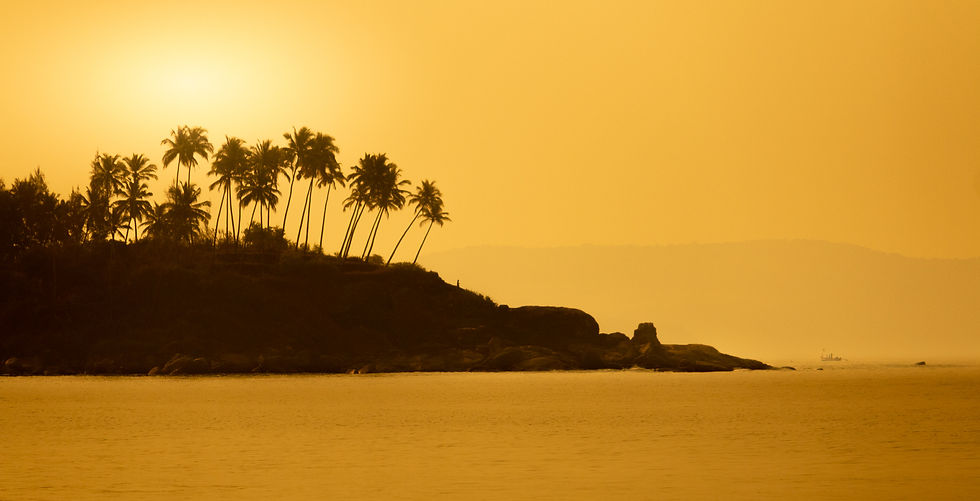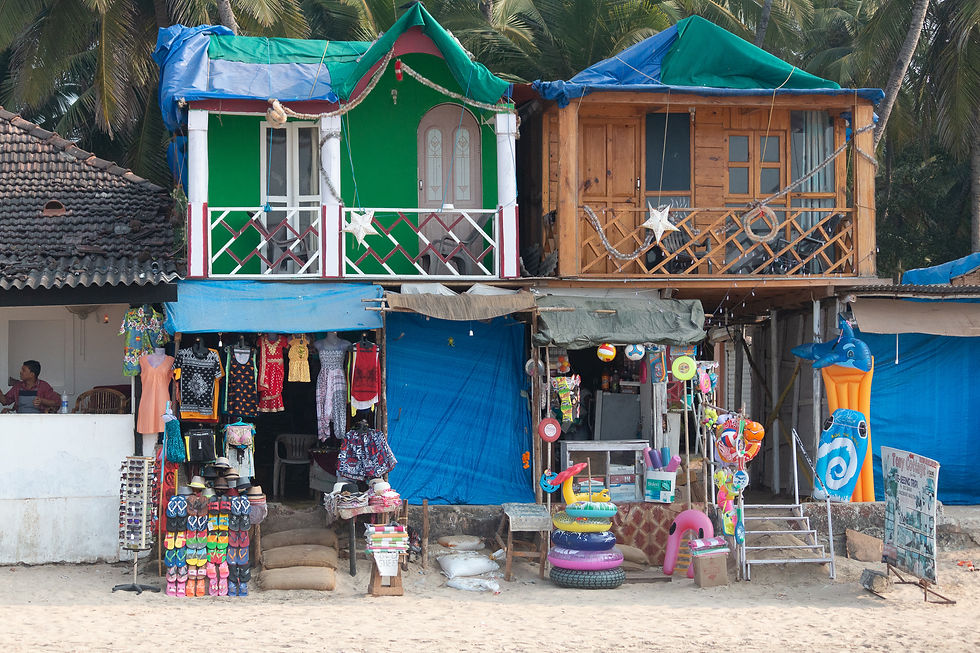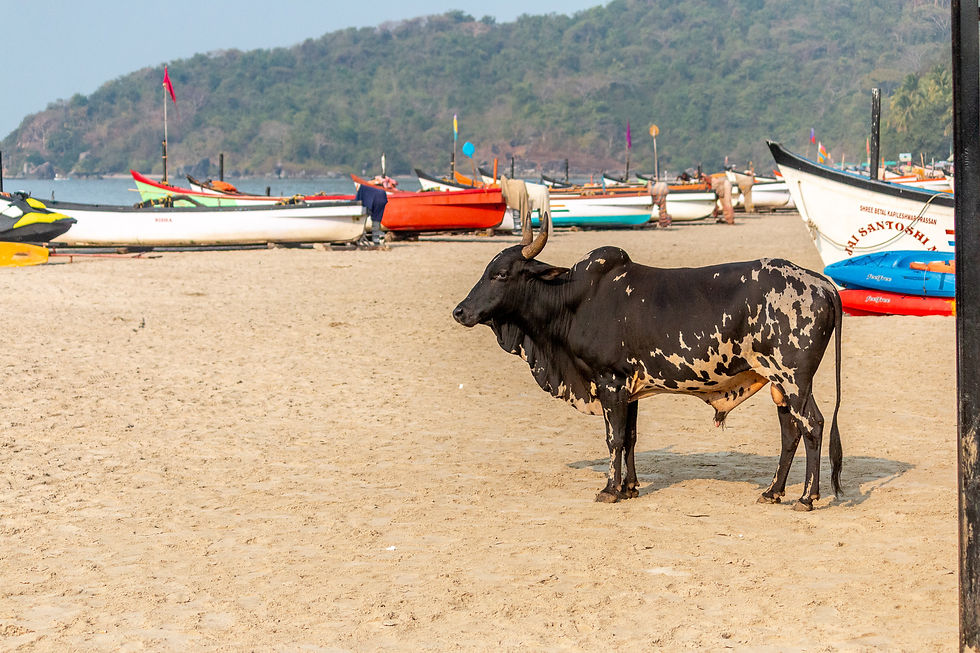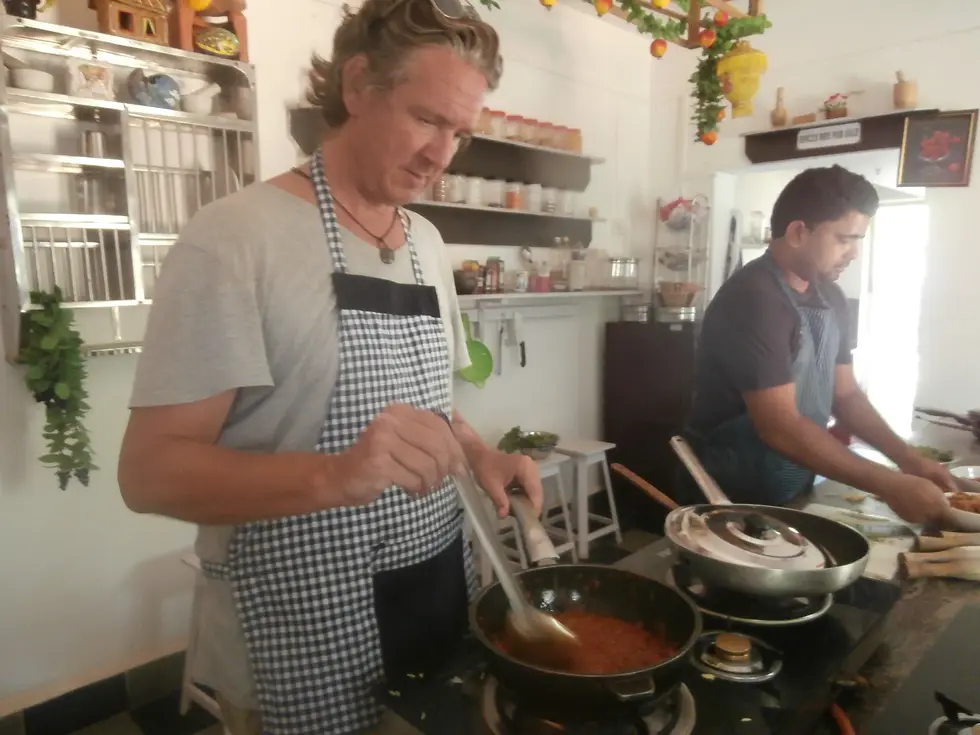Nuts and Bolts: Travel Tips for Visiting Palolem, India
- Rand Blimes

- May 11, 2025
- 8 min read

Nuts and Bolts posts give you the practical information you need, but without stripping away the humor, mishaps, and little victories that make real travel what it is. These aren’t just guides. They’re how we actually did it—mistakes, triumphs, and all.
This page has some travel tips for visiting Palolem Beach, Goa, to aid in planning your own trip. Remember, we are a family of five, and we travel mostly to eat. We were in Palolem in February, 2016. If your trip to Palolem is significantly longer/shorter/with a different focus, you may have a very different experience.
Travel Tips for Visiting Palolem: Follow that Tout!
We were pretty tired by the time we stepped down from the small set of rickety wooden stairs onto the sand of Palolem Beach in the State of Goa, India. We had taken an overnight train from Ernakulam (near Kochi) to Ankola, and then spent several hours on a bus to get to Palolem.
So we felt a bit like we had been exfoliated by road dust, marinated in sweat, and gently tenderized by potholes.
And then came the touts. They descended on us like we were the last tourists on Earth. They crowded around us, pushing, reaching, shouting, each louder than the next, extolling the qualities of the “very-good-price” accommodations they wished to show us.
Decision time.
The Pop-Up Town That Vanishes With the Rain
Each tourist season on Palolem Beach in Goa, a small architectural miracle unfolds: an entire beachfront village arises almost overnight. Guesthouses—crafted from plywood, bamboo, canvas, palm thatch, and varying levels of wishful thinking—are built just a few steps from the sea.
These temporary shelters range from charmingly rustic to delightfully ramshackle, all designed to catch the breeze and the backpackers.
But when the monsoon threatens, the whole thing vanishes. Dismantled, packed away, or simply left to the mercy of the rain, it’s like the tide came in and took the town with it—until it all rises again, one hammock and solar shower at a time, the following year.

One Tout to Guide Them All
I picked one of the touts crowding around us more or less at random.
"You. Show us your place!" I shouted over the cacophony.
Off we went. The other touts followed along, hyenas waiting for scraps that might fall from the jaws of the lion . . . and that worked out for them (and us). It turned out one of those hyenas jumped in when we didn’t like any of the places the first tout showed us. And he sold us on a cute little set of bungalows.
We dropped our bags, showered the travel dust off, and kicked back for a week of just sitting on the beach.
There was some trepidation. We had gotten bored and felt a bit trapped in our previous beach week in Mirissa, Sri Lanka.
But it turned out we loved Palolem. I still hope to one day go back and just spend the whole season sitting on a beach in Goa. And Palolem would be the perfect place to do it.

Weather in Palolem: When to Come and When to Run
The season in Goa is determined by the Monsoon, which wraps up sometime around the end of October and will kick back off around April. That is your window for beach bliss.
Our little ephemeral bungalow didn’t have AC, but we didn’t really miss it. The bungalow got warm in the late afternoon, but there is no need to be indoors at that point. Take your nap in a hammock in the shade. Then take a swim. You are now cooled off.
Getting to Palolem
Palolem may feel like the end of the world in the best possible way—but thankfully, it’s pretty accessible.
Our journey to Palolem was a bit convoluted because we initially planned to spend half a week in Karnataka, and the other half in Goa. We decided to consolidate in just one location, and Palolem was our choice. So we rode the train to Karnataka and the bus from there to Palolem. If you are more organized than we were, you will likely have a simpler time.
By Train
The closest major train station is Canacona (sometimes called Chaudi), just 3 km from Palolem. If you’re lucky, your train will actually stop there. If not, aim for Margao (Madgaon), one of the biggest stations in South Goa, about an hour away. From Margao, you can grab a taxi or a local bus.
By Taxi
If you're flying into Goa’s Dabolim Airport, Palolem is about a 90-minute drive south. You can hire a prepaid taxi at the airport—reliable, safe, and air-conditioned, if slightly overpriced. If you're on a budget, consider taking the train or a bus from the nearby Vasco da Gama station.
By Bus
There are local and state-run buses from Margao and other towns in Goa (and Karnataka) to Canacona. Cheap, colorful, and occasionally featuring a surprise chicken as a passenger.
From Canacona, it's a quick rickshaw ride to Palolem.
However you get there, rest assured that the final approach to Palolem—lush jungle giving way to golden sand—is worth every transfer, rickshaw, and wayward train schedule.
Sleeping in Palolem for the Cheapskate Family
We didn’t book accommodations in Palolem ahead of time, and things worked out without a hitch. We turned up in the middle of the high season and had touts fighting to show us bungalows. If you are very risk averse, I would still recommend just booking a night or two in advance and then look around for something you like and move.
As of 2015, there is nothing very fancy here. Remember, the bungalows on the beach are all temporary structures. If you want 4-star accommodations... or, really, 1-star . . . if you need stars, Palolem may not be your cup of chai.
We got simple, functional rooms right in the middle of the beach for ₹800 (they started asking about ₹1100, and we bargained them down).
Getting Around
Most of what you want in Palolem is right on the beach, or on the small street lined with shops and restaurants just off the beach. All easy walking distance. There are taxis and rickshaws waiting just off the beach for trips to/from the train/bus station, to the Anjuna Market, or, if you run low on cash like we did, to the nearest functioning ATM.
Where to Eat (and Why to Bring Fireproof Taste Buds)
Our week on the beach in Mirissa, Sri Lanka, was a bummer in large part because the food scene was disappointing. Palolem is a totally different story. Just like the temporary bungalows, temporary restaurants pop up on the beach.
Our favorite places (remember, this was back in 2015—things may be different now) were at the far north end of the beach. We had many amazing dinners, sitting on cushions at a low table on the sand, listening to the gentle lapping of waves, eating curries that absolutely set our mouths ablaze. They were soooooo GOOOD!!!
There are also places to eat on the small street just off the beach. We wandered inland and had lunch at these places a few times, and everything we ate was quite good.
Pro tip: if you can’t eat spicy food, and you are planning a trip to Goa, work up to it. Start slow, eating the “medium” spicy salsa with your chips. Start putting a medium-gentle chili (like a jalapeño) in whatever you are making yourself for dinner. Gradually start adding more chili, or hotter chili to everything you eat. Start months before you come, and almost anyone can get used to eating spicy food.
Because Goa is the land of vindaloo, and the vindaloo you can get at any little place in Palolem is amazing.
A Brief History of Vindaloo (Spoiler: It’s Not Just About the Heat)
Vindaloo may have a reputation as the fiery badge of honor for spice-loving masochists, but its roots are far more nuanced—and actually Portuguese. The dish began life as "carne de vinha d’alhos," which literally means meat with wine and garlic. Portuguese colonists brought it to Goa in the 15th century, and Goan cooks did what great cooks always do: they adapted. Wine was swapped for palm vinegar, local spices were tossed in with abandon, and chilies (brought by the Portuguese, by the way) were enthusiastically embraced.
The result? A tangy, garlicky, spicy-sour curry that’s nothing like the generic “hot vindaloo” you might have chugged water through in a British curry house. Traditionally, Goan vindaloo is made with pork, though chicken is more common on the beaches of Palolem.
Vindaloo in Goa is not just spice for spice’s sake. But it is spicy. Always. There is no version of “mild” vindaloo. So, if spicy food isn’t your thing right now, start a training regimen. Work up to it. Anyone can increase their tolerance to spicy food.
And the vindaloo in Goa is worth the burning price of admission.
What To Do
Sit on the beach
Duh. This is why you came here. Bring a book. Or ten.

Early Morning Boat to See Dolphins
There are boats all up and down the beach that you can hire to take you out to see the dolphins. And this isn’t the mad dash, intrusive dolphin watching of Lovina Beach in Bali. Our boat plodded out into the ocean, the driver cut the engines. We sat quietly, and dolphins started popping up all about us.
Anjuna Market
Each Wednesday, there is a large flea market that takes place at Anjuna, a few hours from Palolem. This is a tourist market, not a local market. You can buy anything a traveler may wish for, and quite a bit no traveler would wish for at Anjuna.
I am pretty sure my daughters looked at every pair of earrings in the entire place.
To get to Anjuna, the bus is much cheap, but you will need to change busses in Margao. Total, you will pay about ₹100–₹200 for the bus. We hired a taxi driver to drive us up, wait for us for a few hours, and then drive us back to Palolem. We paid a bit more than 5 times what the bus would have cost, but for us, the convenience was worth it.

Cooking Class
My wife and I took a cooking class. There are several that take place on Palolem. Make sure to check the menu for the class, and make sure you sign up for your preference of vegetarian/non-vegetarian.

Quiet Raves
There are often quiet raves, where everyone wears headphones to hear the music, on the bluff at the south end of Palolem. These quiet raves help Palolem be a nice spot for groups with differing preferences for party/non-party beaches. If you have no interest in dancing the night away but want to have a good chuckle, head up to a vantage point where you can see a writing, pulsing mass of sweaty bodies getting their groove on as one... in utter silence from your point of view.
Goa is a worthy destination, especially for long-term travelers. Because travel can be hard work, and sometimes you need a week of sitting on a beach, getting addicted to the most deliciously painful food you have ever eaten, and letting yourself fall under the spell of a pulsing, silent rhythm.



Comments